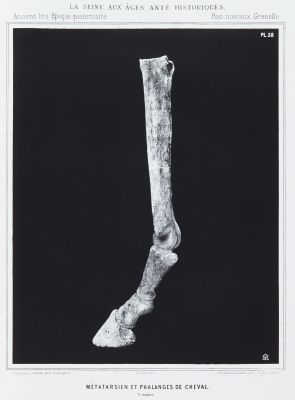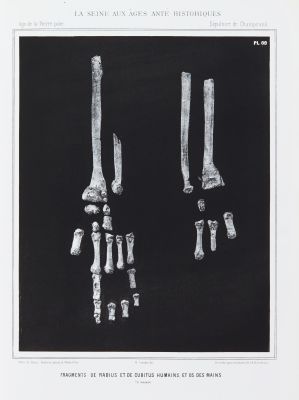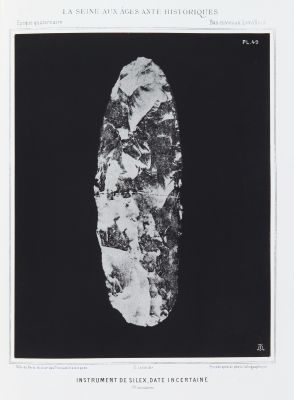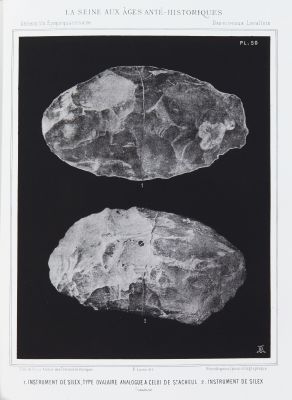
Title
Tête d’ursus spelaeus sinciputArtist
Bilordeaux, Adolphe (French, 1807-1872)Publication
La Seine aux âges anté-historiquesDate
1883Process
Photo-lithographAtelier
A. BilordeauxImage Size
24 x 19 cm
Bilordeaux, a lithographer, studied photography with Gustave Le Gray. He initially proposed working with photography and lithography in 1855 and worked with photolithography in 1857. The following brief explanation of his process was presented at a meeting of la Société d’encouragement pour l’industrie nationale, December 11, 1868: Monsieur Amédée-Durand, the chairman, read a letter from Monsieur Ernest Lacan, head of the photography section at the historical service of the city of Paris, who informed the Society of the processes used by Monsieur Bilordeaux for producing directly on stone photographic images that can be printed in the press by ordinary processes; a transparent positive image having been made is used to produce a negative image on stone previously covered with a [light-] sensitive coating. This image, after removing the parts of the coating that are not impressed, is inked with fatty ink that adheres to the stone and not to the coating [that has been] impressed by light. The result is a sort of positive print, possessing the properties of ordinary drawings on lithographic stone and, like them, able to produce a regular print run in the lithographic press. Photolithographic plates can now be routinely produced which combine the qualities of remarkable execution with the advantage of being very cheap. Monsieur Lacan, present at the meeting, displayed ten prints representing specimens of paleontology produced with no retouching, a crucial aspect of great importance, particularly for subjects of natural history. [1]
Eugène Belgrand (1810-1878) was a French engineer who made significant contributions to the modernization of the Parisian sewer system during the 19th century rebuilding of Paris. Prior to 1850, the water system in Paris was inadequate for its growing population. Wastewater was discharged into the Seine, a primary source of the critically limited supply of drinking water. Baron Haussmann, tasked by Napoléon III to modernize the city, appointed Belgrand as Director of Water and Sewers of Paris in March 1855. Belgrand embarked on an ambitious project. The tunnels he designed were intended to be clean, easily accessible, and substantially larger than the previous Parisian underground. By 1870 he created an innovating network of underground pipes to prevent Paris from being flooded. Under his guidance, Paris’s sewer system expanded fourfold between 1852 and 1869. He also addressed the city’s fresh water needs, constructing a system of aqueducts that nearly doubled the amount of water available per person per day and quadrupled the number of homes with running water.
Public reaction to the improvements was overwhelmingly favorable, supported by tours of the newly constructed sewer system and a series of photographs taken by Nadar, pioneering the use of artificial lighting for photography. Belgrand shared his insights with others, writing "monumental publications" such as this portfolio detailing his work and the science behind it. Belgrand’s projects remain "one of the most extensive urban sewer systems in the world" and served as a "transitional phase" leading to modern wastewater processing. To commemorate his work in Parisian civil engineering, Belgrand’s name is one of 72 names engraved on the Eiffel Tower”
The plates that make up this volume have not been are in a special héliolithographie process applied in full for the first time in the workshops of the Service des Travaux historiques, and excluding the possibility of error. Vol. I [Texte] contains 5 plates from photographs by Drivet’s two heliogravure processes, on in lined half-tone and the other in random dot process. Vol. II [Planches de paléontologie] contains 79 plates, 4 of them by Drivet in lined half-tone and the rest in photolithography by A. Bilordeaux in association with E. Lacan. [2]
References
[1] Hanson, David Checklist of photomechanical processes and printing 1825-1910, 2017 p. 21
[2] Hanson, David A. The David A. Hanson Collection of the History of Photomechanical Printing. The Sterling and Francine Clark Art Institute. Catalog 2000 (supplement)
Planteraux, Weekly Transmission 14 IV Thursday 6 April 2017











